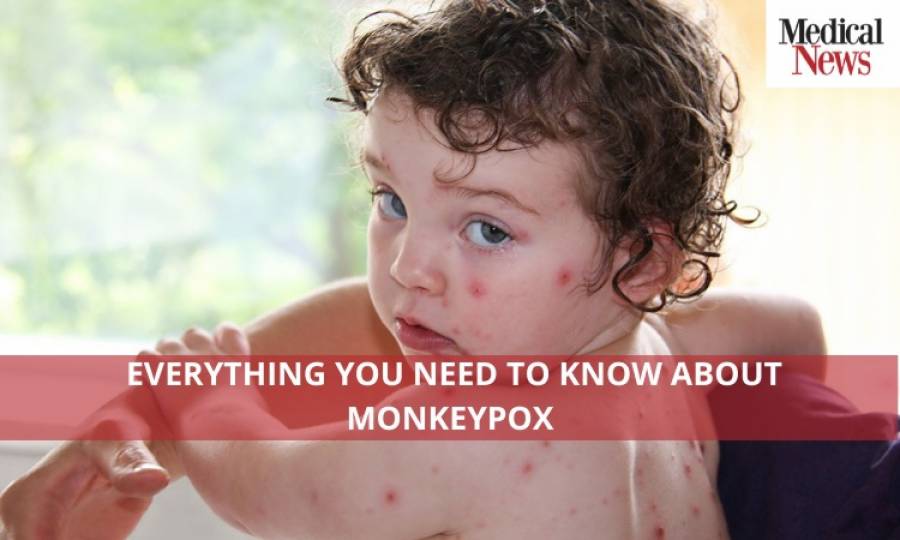Everything You Need to Know About Monkeypox

Health officials in Pakistan have recently issued a warning about the spread of Monkeypox in Europe, the United States, and the United Kingdom.
According to a National Institute of Health (NIH) statement, federal and provincial health officials have been put on high alert, and directives have been given for airports and other gateways to be monitored. The authority added that all major private and government hospitals had been ordered to set up isolation wards.
So far, Monkeypox has been confirmed in 92 nations, and 28 countries are suspected of having the virus.
The Monkeypox Outbreak
Since May 13, 2022, cases of Monkeypox have been reported to World Health Organization from 12 non-endemic Member States.
Although epidemiological investigations are ongoing, there are no confirmed travel linkages between reported cases and endemic areas, i.e., West Africa, especially the Democratic Republic of Congo.
However, no associated deaths have been reported to date.
What is Monkeypox?
Monkeypox is a zoonotic viral disease (a virus transmitted from animals to humans) with symptoms that are strikingly similar to those seen in smallpox patients in the past; however, it is less severe clinically.
It is caused by the monkeypox virus, which belongs to the Poxviridae family's orthopoxvirus genus. While there is no confirmed animal reservoir for this virus, African rodents are thought to play a role in transmission.
It is usually a self-limiting disease, although it can be severe in some people, such as youngsters, pregnant women, or those who have had their immune system suppressed by other illnesses.
Why Is This Disease Termed Monkeypox?
The term "monkeypox" stems from the first known disease cases in animals, which occurred in 1958 in two episodes in monkeys maintained for research.
However, the virus did not spread from monkeys to humans; hence monkeys are not important disease carriers.
Signs and Symptoms of the Disease
After around 5 to 14 days of contracting the virus, the patient complains and presents with fever, muscle pain and enlarged lymph nodes.
A further one or two days later, the rash appears starting from mouth to face, then trunk and arms. The rash affects the face (in 95 per cent cases), palms of the hands and soles of the feet (in 75 per cent cases).
The rash progresses from macules (flattened lesions) to papules (slightly raised firm lesions), vesicles (clear fluid-filled lesions), pustules (yellowish fluid-filled lesions), and crusts that dry up and flake off. They are a few hundred to several thousand in number.
Moreover, all the lesions evolve simultaneously (unlike chickenpox) and last 2 to 4 weeks.
How Does the Monkeypox Virus Transmit?
Direct contact with infected animals' blood, body fluids, or cutaneous or mucosal lesions can result in animal-to-human (zoonotic) transmission.
Close contact with respiratory secretions and skin sores of an infected person or recently contaminated objects can result in human-to-human transmission.
Droplet respiratory particle transmission typically necessitates prolonged face-to-face contact, putting health workers, household members, and other close contacts of active cases at considerable risk of contracting the disease.
How to Treat It?
Monkeypox can be treated by relieving symptoms, managing complications, and minimising long-term consequences.
There are shreds of evidence to support that vaccinations for smallpox have been shown to be effective for Monkeypox as well but no such claims can be held true until further investigations take place.
However, according to the FDA, two smallpox antiviral drugs have shown to be effective against Monkeypox. These are namely Brincidofovir and Tecovirimat.
Additionally, patients should be given plenty of fluids and food to maintain proper nutritional status. Consulting a doctor is vital before taking any medicinal intervention. At the same time, secondary bacterial infections should be treated according to the guidelines.
Infection Control Measures for Monkeypox
Patients who do not need to be admitted to the hospital can be isolated at home using protective measures.
Monkeypox patients should not leave the house unless medical attention is required. If at all possible, they should avoid interaction with wild or domestic mammals.
Members of the house who are not sick should avoid contact with the monkeypox patient.
Wear a surgical mask if you have Monkeypox, especially respiratory symptoms (e.g., cough, shortness of breath, sore throat). Other family members should consider putting on a surgical mask when using the PPE for patients is not possible (e.g. toddlers).
Infected persons and household members should wash their hands with soap and water or use an alcohol-based hand rub after touching the material, clothing or environmental surfaces which come in contact with the lesion.
Soiled dishes and eating utensils of an affected individual should be washed in a dishwasher or by hand with warm water and soap.
PPE should be disposed of before leaving the patient's isolation area.
Trending
Popular
Over one billion people worldwide struggle with obesity, WHO study ...
-
Health Alert: Dried fruits found to ...
11:47 AM, 2 Mar, 2024 -
Quitting smoking early linked to better ...
09:56 AM, 19 Feb, 2024 -
Medical colleges should prioritize ...
11:03 AM, 16 Feb, 2024 -
JSMU workshop on quality assurance in ...
02:58 PM, 6 Feb, 2024




